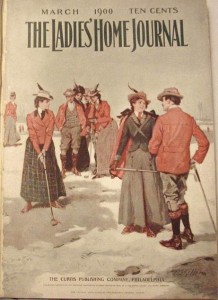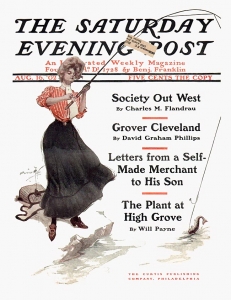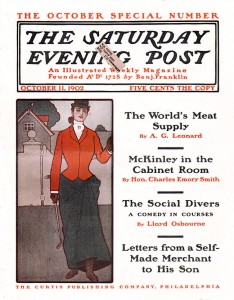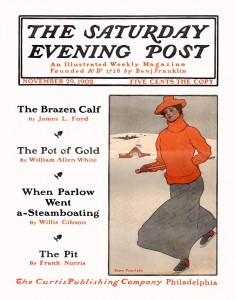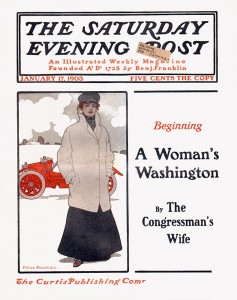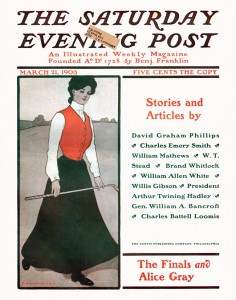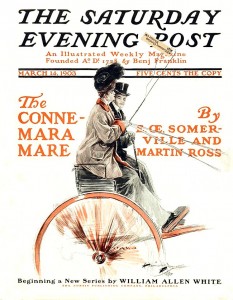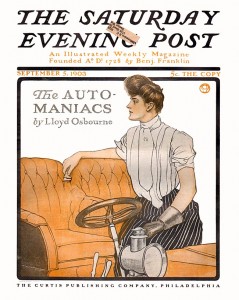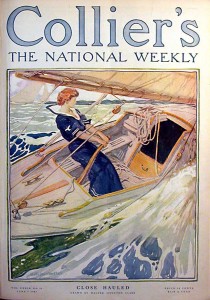Illustrating Active, Sporting Women
By Joyce K. Schiller, Curator, Rockwell Center for American Visual Studies
As early as 1893, Vogue magazine began commissioning illustrators to include images of active young woman participating in sporting activities. For example, the American illustrator Charles M. Relyea (1863-1932) produced cover illustrations for the magazine featuring a woman driving a boat and another walking through a woods, with a shot gun in hand, flushing a rabbit. It took most other American magazines a bit longer to shift their cover images of women from merely pretty ladies involved in homey, domestic, or romantic activities to illustrations of active self-possessed young ladies participating in sporting activities. Within the first decade of the 20th century, magazines such as The Saturday Evening Post, Collier’s, the National Weekly, and The Ladies’ Home Journal shifted their cover focus to include new images of active, sporting women (as seen below).
Arthur Ignatius Keller (1866-1924) Harrison Fisher (1875-1934)
Golfing Party Lady Fishing
Cover illustration for The Ladies’ Cover illustration of The Saturday Evening Post
Home Journal (March 1900) (August 16, 1902)
I’m certain that wunderkind illustrator Charles Dana Gibson’s 1890s development of his fresh, young, and energetic beauties were a spur to subsequent shift of ladies’ portrayals. For example, look at the above composition of Keller’s Tyrolean teeing ground for The Ladies’ Home Journal. The story visualized here is more about courting than it is about women pursuing vigorous physical activities. But by 1902 The Saturday Evening Post is publishing dynamic cover illustrations of young women pursuing their sports. In August, Harrison Fisher’s cover image is less concerned with the woman’s feminine beauty than it is with her prowess handling the fish on her line.
In October and November of 1902 and again in January and March of 1903, The Post published four cover illustrations of pretty young women involved in some sort of sport all by the illustrator Peter Fountain. The first of this group is a woman dressed for riding to hounds side saddle. In her red coat, riding skirt with internal hooks and eyes to hold a portion of it out of the way, her tailored white stock with its horseshoe pin, and hard Bowler hat, she appears to move toward her horse hold her crop in hand while looking refined and sophisticated. The following months the related cover images by Fountain are of more active woman often looking more or less refined. Wisps of hair sometimes escape from their hair arrangements.
It was these four illustrations by Peter Fountain* that were the impetus for this essay. This was not only because they were rather early such images of active sporting women, but also because the skater and automobile driver appear so confident even as they pursue unusual activities—unusual either in look or in activity. Compare Peter Fountain’s cover illustration with a concurrent SEP cover illustration of a well-dressed (frou-frou hatted) woman holding the reigns of her horse-drawn carriage while the coachman looks on askance by Harrison Fisher. Fountain’s auto driver wears what appears to be a man’s service cap with a short visor, instead of wearing a woman’s muslin cap, a scarf, or a bonnet.
Harrison Fisher (1875-1934);
Edward Penfield (1866-1925); An Auto-Maniac; Cover illustration of The Saturday Evening Post (September 5, 1903)
Later that same year another SEP cover by Edward Penfield illustrated a Gibson-like woman wearing a formal riding white shirt with a similar white stock and horseshoe pin we saw on Peter Fountain’s October 1902 SEP cover. But Penfield’s woman has the sleeves of her shirt casually pushed up above her elbows. She wears a driving glove on her left hand and hold the other glove in her right hand.
These illustrations are visual evidence of the growing perception of the shifting roles of women around the turn-of-the-century. While I’ve already written about women’s growing insistence on driving their own carriages (see “Women With Drive” https://www.rockwell-center.org/exploring-illustration/women-with-drive/), I believe that the increasing number of illustrations of energetic women engaged in sports are indeed related.
One of the aspects of this shift is rarely seen or addressed in concurrent fine art. That is the insistence of art historians to continue to expound on women’s images being tied to the domestic sphere well into the early 20th century. While that may indeed mostly be the case in fine art, illustration art provides us with a more realistic view of middle and upper class women’s lives at the time. In order to really see an overview of how women lived and played in the United States from 1890 through 1910 we would need to look at illustrations of those who were poor, those who were working class (like shop girls or women who worked in mills etc.), the women of the middle class, women of the upper class. The plethora of illustrations of women at this time, from posing beauties to women active in the thick of things, helps to broaden our understanding of what was possible for women in the new century.
Walter Appleton Clark (1876-1906); Close Hauled; Cover illustration for Collier’s The National Weekly (June 8, 1907)
* One of the reasons I hesitated to write about these images for so long, was because I could find nothing about an illustrator named Peter Fountain. Recently I was lucky to stumble on an unusual fact about Guernsey Moore (1874-1925) and J. J. Gould (1880-1935)—two illustrators who collaborated and created an imaginary illustrator they called, “Peter Fountain.”
These two designers, both Philadelphians, worked together for some time under the name of “Peter Fountain,” a fictitious personage who aroused attention for reason of the very interesting quality of his work, which appeared on the covers of “The Saturday Evening Post,” and by his disappearance from the field in a mysterious manner, no less sudden or unheralded that his début. While much work was done jointly by Messrs. Gould and Moore, much was presented either anonymously or with a combined monogram of “J.J.G.,” and “G. M.,” and the four sketches here presented constitute the only work over the “Peter Fountain” signature.
Charles Matlack Price, Posters: a critical study of the development of poster design in continental Europe, England and America (New York: George W. Bricka, 1913): 330, 341.
July 31, 2014
By Joyce K. Schiller, Curator, Rockwell Center for American Visual Studies, Norman Rockwell Museum


